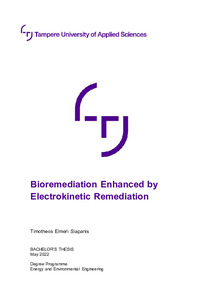Bioremediation enhanced by electrokinetic remediation
Siapanis, Timotheos Elmeri (2022)
Siapanis, Timotheos Elmeri
2022
All rights reserved. This publication is copyrighted. You may download, display and print it for Your own personal use. Commercial use is prohibited.
Julkaisun pysyvä osoite on
https://urn.fi/URN:NBN:fi:amk-2022053013328
https://urn.fi/URN:NBN:fi:amk-2022053013328
Tiivistelmä
This study was carried out to give an overview of the applicability of electrokinetic methods in soil remediation. The main focus was on using pulsed electrical current with reverse polarity combined with bioremediation in treating soils contaminated with PAHs and PFAs. Methods used to gather information were based mainly on literature review from online sources and previous case studies of EKOGRID.
EKOGRID is the company that commissioned the theme of this thesis and provided baseline knowledge related to electrokinetic remediation methods.
Results indicate that pulsed current with reverse polarity can be efficiently used in removing PAHs, PFAs and other type of contaminants from soil. This method proved to be more efficient that the other electrokinetic remediation methods because of the better mobilization of contaminants facilitating the efficient biodegradation of the contaminants, including PAHs and PFAs. By consuming less electricity, the energy efficiency that this electrokinetic system withholds is a major advantage over other remediation techniques. However, further research is required to find out the effects of different remediation conditions and parameters, especially with respect to PFAs decomposition.
EKOGRID is the company that commissioned the theme of this thesis and provided baseline knowledge related to electrokinetic remediation methods.
Results indicate that pulsed current with reverse polarity can be efficiently used in removing PAHs, PFAs and other type of contaminants from soil. This method proved to be more efficient that the other electrokinetic remediation methods because of the better mobilization of contaminants facilitating the efficient biodegradation of the contaminants, including PAHs and PFAs. By consuming less electricity, the energy efficiency that this electrokinetic system withholds is a major advantage over other remediation techniques. However, further research is required to find out the effects of different remediation conditions and parameters, especially with respect to PFAs decomposition.
